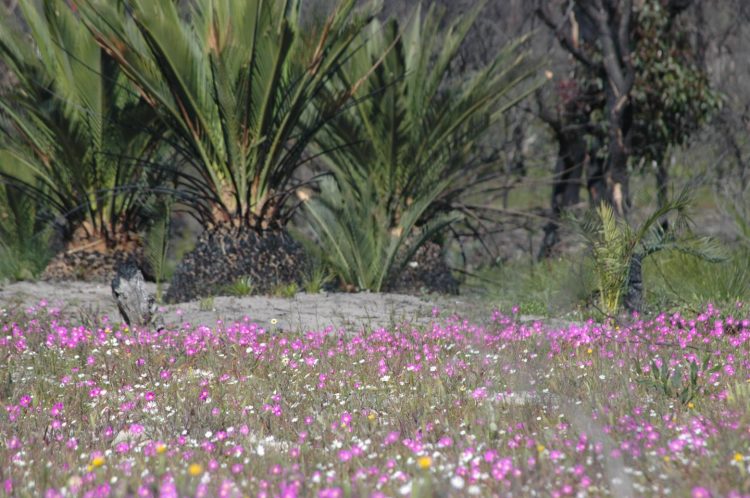Necessity at the roots of innovation: The scramble for nutrients intensifies as soils age

Nutrient poor soils in the Jurien Bay ecosystem support a very diverse plant community. Credit: ABC/Ben Turner
“Plants cope with phosphorus scarcity in a similar way above-ground by making phosphorus-efficient leaves,” Turner said. “But below-ground they're using many different strategies to obtain phosphorus, and the diversity of those strategies increases as soil phosphorus declines.”
The properties of soil, “the living skin of the Earth,” drive biological processes, but these properties change as soils age. One of the best places in the world to study what happens to plant communities as soils age is the Jurien Bay dune chronosequence in Australia, a series of with new to ancient soils.
New dunes form during interglacial periods of high sea levels, as the ocean throws sand up onto the shore. Meanwhile, inland dunes are gradually covered by kwongan, exceptionally species-rich shrubby vegetation unique to southwestern Australia. Soil phosphorus has gradually leached away during the past 2 million years, leaving some of the most impoverished soils in the world on the oldest dunes.
Turner and colleagues from the University of Western Australia and the University of Montreal identified and counted all of the plants at a series of six dune systems, then identified how each species acquired phosphorus from the soil. As the ecosystem aged, the number of plant species and the number of phosphorus acquisition strategies increased.
Some plant roots join forces with mycorrhizal fungi, which extend out like a net from plant roots to capture nutrients. Other plants form clusters of roots that exude carboxylates to “mine” the soil for phosphorus. Some resort to parasitism and carnivory, extracting phosphorus from other organisms. Even plants growing next to one another used different nutrient capture strategies with equal success.
“There's considerable interest in understanding how plant traits influence the assembly of plant communities,” Turner said. “This study highlights the potential importance of nutrient acquisition strategies in this process, particularly for species-rich ecosystems.”
Complete results of this study, supported by the Australian Research Council and the Kwongan Foundation, are published in the journal Nature Plants.
###
The Smithsonian Tropical Research Institute, headquartered in Panama City, Panama, is a part of the Smithsonian Institution. The institute furthers the understanding of tropical nature and its importance to human welfare, trains students to conduct research in the tropics and promotes conservation by increasing public awareness of the beauty and importance of tropical ecosystems. Website: http://www.
Reference: Zemunik, G., B.L. Turner, H. Lambers, and E. Laliberté (2015). Diversity of plant nutrient-acquisition strategies increases during long-term ecosystem development. Nature Plants.
Media Contact
All latest news from the category: Life Sciences and Chemistry
Articles and reports from the Life Sciences and chemistry area deal with applied and basic research into modern biology, chemistry and human medicine.
Valuable information can be found on a range of life sciences fields including bacteriology, biochemistry, bionics, bioinformatics, biophysics, biotechnology, genetics, geobotany, human biology, marine biology, microbiology, molecular biology, cellular biology, zoology, bioinorganic chemistry, microchemistry and environmental chemistry.
Newest articles

Webb captures top of iconic horsehead nebula in unprecedented detail
NASA’s James Webb Space Telescope has captured the sharpest infrared images to date of a zoomed-in portion of one of the most distinctive objects in our skies, the Horsehead Nebula….

Cost-effective, high-capacity, and cyclable lithium-ion battery cathodes
Charge-recharge cycling of lithium-superrich iron oxide, a cost-effective and high-capacity cathode for new-generation lithium-ion batteries, can be greatly improved by doping with readily available mineral elements. The energy capacity and…

Novel genetic plant regeneration approach
…without the application of phytohormones. Researchers develop a novel plant regeneration approach by modulating the expression of genes that control plant cell differentiation. For ages now, plants have been the…





















